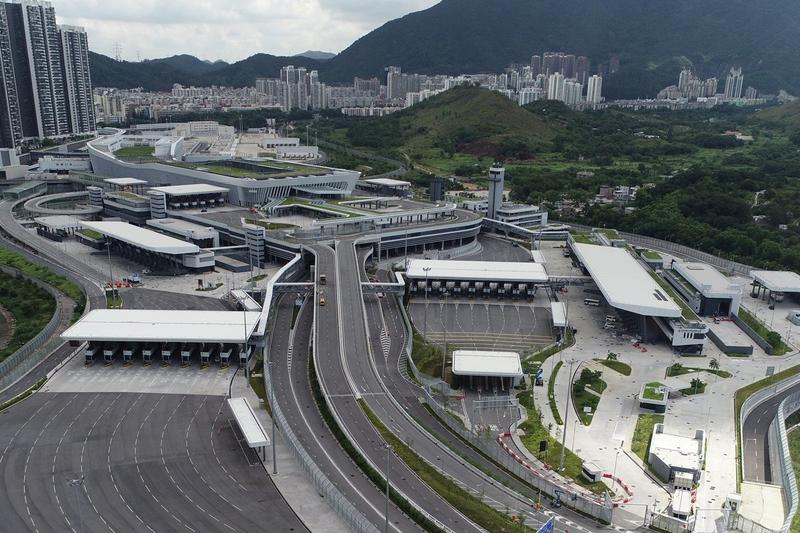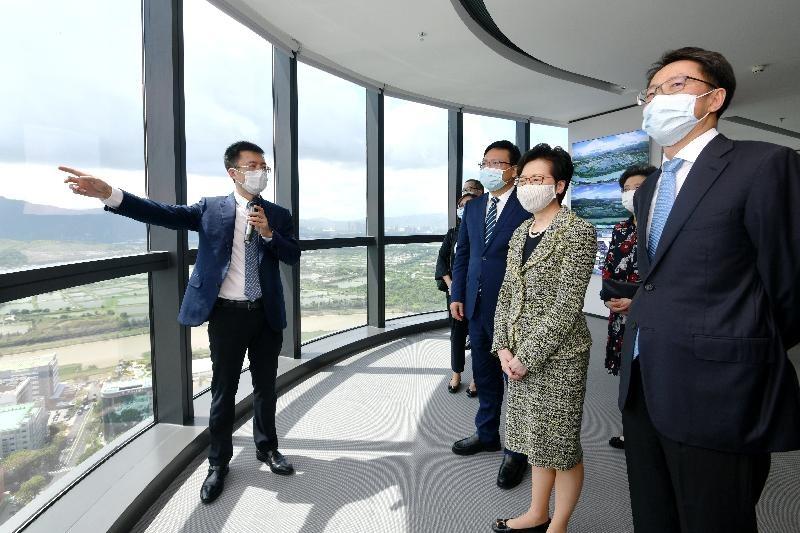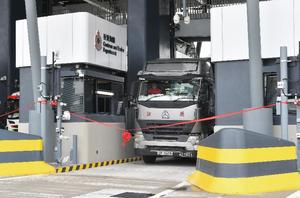 This Aug 21, 2020 photo shows a view of the Liantang Port/Heung Yuen Wai Boundary Control Point. (PHOTO / HKSAR GOVERNMENT)
This Aug 21, 2020 photo shows a view of the Liantang Port/Heung Yuen Wai Boundary Control Point. (PHOTO / HKSAR GOVERNMENT)
Hong Kong Chief Executive Carrie Lam Cheng Yuet-ngor on Wednesday said that the opening of the Heung Yuen Wai Control Point at the border with Shenzhen marked a milestone in cooperation between the two cities, as the new facility will further ease the flow of goods across the border.
Lam made her remarks at the opening ceremony of the new control point on Wednesday morning. Heung Yuen Wai Control Point, is named Liantang Port in Shenzhen, is the seventh land transport port between Hong Kong and Shenzhen.
The new crossing started operation at 4 pm on Wednesday, but because of COVID-19 restrictions, only cargo trucks are currently allowed.
Lam said the opening of this control point represents another major step in achieving the “one-hour living circle” plan within the Guangdong-Hong Kong-Macao Greater Bay Area
At the opening ceremony, Lam said that the new control point can enhance the smooth flow of goods across the border by shortening the travel time between Hong Kong, Shenzhen and the eastern region of Guangdong province.
The smoother and more efficient flow of trade can further facilitate cooperation and development between the region and also with neighboring provinces, she added.
ALSO READ: Cooperation to fortify Shenzhen-HK ties
Lam said the opening of this control point represents another major step in achieving the “one-hour living circle” plan within the Guangdong-Hong Kong-Macao Greater Bay Area, after the completion of various transportation projects, including Hong Kong’s high-speed railway link and the Hong Kong-Zhuhai-Macao Bridge.
The Bay Area development initiative has greatly enhanced the importance of this cross-border project, which was hammered out in 2008, she said.
After the control point opens to travelers and private cars in the future, the facility has the capacity to handle daily traffic of 30,000 passengers and 17,850 vehicles, including 15,000 trucks, 2,000 cars and 850 buses.
IN PHOTOS: New border crossing facility opens between HK and Shenzhen
The passenger areas are 5G ready for commuters’ convenience.
The new control point also set a model and provided opportunities to optimize the existing crossings between Hong Kong and Shenzhen, Lam added.
 Hong Kong Chief Executive Carrie Lam Cheng Yuet-ngor (second right) receives a briefing on the latest developments of the Shenzhen Innovation and Technology Zone during a visit to the Shenzhen-Hong Kong Innovation and Technology Co-operation Zone in Shenzhen on August 26, 2020. Looking on are Deputy Director of the Hong Kong and Macao Affairs Office of the State Council Zhang Xiaoming (first right) and Mayor of the Shenzhen Municipal Government Chen Rugui (third right). (PHOTO / HKSAR GOVT)
Hong Kong Chief Executive Carrie Lam Cheng Yuet-ngor (second right) receives a briefing on the latest developments of the Shenzhen Innovation and Technology Zone during a visit to the Shenzhen-Hong Kong Innovation and Technology Co-operation Zone in Shenzhen on August 26, 2020. Looking on are Deputy Director of the Hong Kong and Macao Affairs Office of the State Council Zhang Xiaoming (first right) and Mayor of the Shenzhen Municipal Government Chen Rugui (third right). (PHOTO / HKSAR GOVT)
With the new control point opening, Hong Kong will be able to tap more opportunities in the enormous markets of the Guangdong-Hong Kong-Macao Greater Bay Area.
In the past, cargo vehicles headed for eastern Guangdong province had to pass through busy districts before crossing the boundary.
READ MORE: Integration 'brings HK fresh opportunities'
"The new crossing can ease the traffic at land-based ports...and improve the clearance and services of Hong Kong ports in general," said Lu Pei-yu, senior engineer of the Civil Engineering and Development Department of the HKSAR government.
Chan Dik-sau, chairman of the Container Transportation Employees General Union, said the transport sector welcomes the operation of the new port. While the clearance for trucks requires complicated procedures and costs more time due to the epidemic, the new checkpoint put into use will help mitigate the situation, he said.
 The first lot of Hong Kong goods vehicles passes through the control points of the Customs and Excise Department to leave the territory during the opening ceremony of the Liantang Port/Heung Yuen Wai Boundary Control Point on Aug 26, 2020. (PHOTO / HKSAR GOVT)
The first lot of Hong Kong goods vehicles passes through the control points of the Customs and Excise Department to leave the territory during the opening ceremony of the Liantang Port/Heung Yuen Wai Boundary Control Point on Aug 26, 2020. (PHOTO / HKSAR GOVT)
The new land port, located in the area planned for innovation and technology sectors, will also offer fresh opportunities for high-tech cooperation between Hong Kong and Shenzhen, Liang Haiming, a Hong Kong-based economist said.
Liang believes that more convenient boundary-crossing travels will provide Hong Kong tech firms with a broader development room.
Analysts believe that Hong Kong, by further integrating into the Greater Bay Area development, can make full use of its advantages in education and professional services and make greater progress, which in return will bolster the Greater Bay Area as a robust growth point of the whole country
Analysts believe that Hong Kong, by further integrating into the Greater Bay Area development, can make full use of its advantages in education and professional services and make greater progress, which in return will bolster the Greater Bay Area as a robust growth point of the whole country.
Chinese authorities in February 2019 unveiled the development outline for the Guangdong-Hong Kong-Macao Greater Bay Area, aiming to build the region into a role model of high-quality development. The Greater Bay Area consists of Hong Kong, Macao and nine cities of Guangdong province.
Zhang Xiaoming, deputy director of the Hong Kong and Macao Affairs Office of the State Council, Luo Huining, director of the Liaison Office of the Central People’s Government in Hong Kong, and top Guangdong and Shenzhen officials also attended the opening ceremony.
After the ceremony, Lam and other officials visited the Shenzhen-Hong Kong Innovation and Technology Co-operation Zone in Shenzhen.
With inputs from Xinhua


